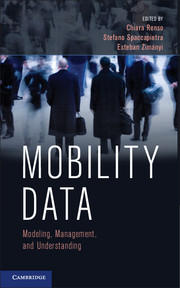Book contents
- Frontmatter
- Contents
- List of Contributors
- Preface
- Acknowledgments
- PART I MOBILITY DATA MODELING AND REPRESENTATION
- PART II MOBILITY DATA UNDERSTANDING
- PART III MOBILITY APPLICATIONS
- PART IV FUTURE CHALLENGES AND CONCLUSIONS
- 15 A Complexity Science Perspective on Human Mobility
- 16 Mobility and Geo-Social Networks
- 17 Conclusions
- Bibliography
- Glossary
- Author Index
- Subject Index
- Plate section
16 - Mobility and Geo-Social Networks
from PART IV - FUTURE CHALLENGES AND CONCLUSIONS
Published online by Cambridge University Press: 05 October 2013
- Frontmatter
- Contents
- List of Contributors
- Preface
- Acknowledgments
- PART I MOBILITY DATA MODELING AND REPRESENTATION
- PART II MOBILITY DATA UNDERSTANDING
- PART III MOBILITY APPLICATIONS
- PART IV FUTURE CHALLENGES AND CONCLUSIONS
- 15 A Complexity Science Perspective on Human Mobility
- 16 Mobility and Geo-Social Networks
- 17 Conclusions
- Bibliography
- Glossary
- Author Index
- Subject Index
- Plate section
Summary
Introduction
The social web is changing the way people create and use information. Every day millions of pieces of information are shared through the medium of several online social networks and online services with a social layer such as Facebook, Google+, Twitter, Foursquare, and so on. People have discovered a new way to exploit their sociality: from work to entertainment, from new participatory journalism to religion, from global to local government, from disaster management to market advertisement, from personal status update to milestone family events, the trend is to be social. Information or content is shared by users through the web by posting images or videos, blogging or micro-blogging, surveying and updating geographic information, or playing geographic-based games. Considering the increase in mobile Internet access through smartphones and the number of available (geo-) social media platforms, we can expect the amount of information to continuously grow in the near future. To understand the potential of this change it is worth noticing the amount of “geo-social information” produced during recent years to be a daily occurrence. The following are just few examples. In August 2006, Flickr introduced the geo-tagging feature; by 2007, more than 20 million geo-tagged photos were uploaded to Flickr. In August 2011, Flickr announced its 6 billionth photo, with an increase of 20% year-on-year over the last 5 years. Similarly, Twitter was born in 2006. The most impressive performance indicator is the increasing rate of messages.
- Type
- Chapter
- Information
- Mobility DataModeling, Management, and Understanding, pp. 315 - 333Publisher: Cambridge University PressPrint publication year: 2013
- 9
- Cited by



